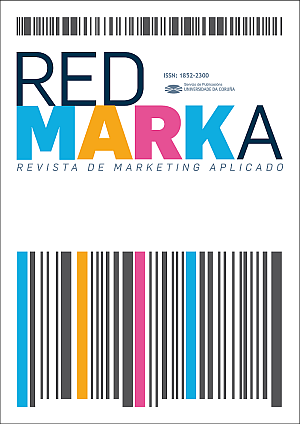Youtube as a tourist marketing tool of Galicia
Main Article Content
Abstract
Although Youtube started as an instrument of "social media" with the passage of time has evolved into a marketing tool, also called "social media marketing " .This Master thesis takes as its object of study the use of Youtube as a tourism marketing tool in Galicia from the point of view of tourism organizations, companies and consumers. In order to determine the purpose of the videos for each user type (public tourism organizations, tourism enterprises and private users), was carried out a content analysis of 80 videos that enabled a categorization of videos related to the tourism in Galicia and the key elements on the preferences of viewers on these videos.
Concurrently, the investigation is completed with the analisys of the projected identity of the top five videos of Galicia on Youtube as well as its perceived image by the spectators. The results obtained are expected to detect trends and dynamics to optimize communication in Youtube for content generators both public and private (companies and individuals).
Keywords:
Downloads
Article Details
References
Andrade, Maria (2009). La imagen del destino turistico imagen percibida del turismo rural de Galicia. (Tesis doctoral inedita). Departamento de Sociologia y Ciencia Politica y de la Administracion. Universidad de A Coruna.
Baloglu, S., & McCleary, K. W. (1999). A model of destination image formation. Annals of tourism research, 26(4), 868-897.
Betancort, H. F., & Ebrahimi, M. (2011). The Role of New Media in Tourism Marketing and Advertisement for Attracting To rists Concentrating on Facebook and YouTube-A Case Study. 13(2), 25-33.
Camprubi Subirana, R. (2011) El rol del turista en la formación de la imagen turística emitida. En San Eugenio, J. (coord.) Manual de Comunicación Turistica. De la información a la persuasión, de la promoción a la emoción (pp. 115-124). Girona: Documenta Universitaria.
De Cicco (2009). Youtube el archivo audiovisual de la memoria colectiva.
Fabry, P. (2008). Le WEB 2.0. S'installe au cour des stratégies touristiques. Espaces, 265, p.12-18. En línea: http://www.vaucluse.cci.fr/files/cci_84/documents/112_doc.pdf. Consultado 20 de abril de 2014.
Gretzel, U., & Yoo, K. H. (2008). Use and impact of online travel reviews. En Information and communication technologies in tourism 2008 (pp. 35-46). Springer Vienna.
Marques Graells, P. (2009). Los anuncios. Ficha para el análisis de mensajes audiovisuales. En línea: http://peremarques.pangea.org/pubmulti.html. Última consulta 10 de marzo 2014.
Martínez, A. C. (2010). Estrategias empresariales en la Web 2.0. Las redes sociales online. Editorial Club Universitario.
Miller, M. (2011). Marketing con Youtube. Anaya Multimedia, España/Madrid.
Madasu, P. (2013). Social marketing and promotion of tourism. Management Insight, 9(1).
Navarro, N. B. (2010). YouTube, un género publicitario (Doctoral dissertation, Universitat Jaume I, [Departament de Ciències de la Comunicació]).
O’Connor, P. (2008). User-generated content and travel: A case study on Tripadvisor. com. En Information and communication technologies in tourism 2008 (pp. 47-58). Springer Vienna.
Reino, S., & Hay, B. (2011). The Use of YouTube as a Tourism Marketing Tool. En Proceedings of the 42nd Annual Travel & Tourism Research Association Conference, London, Ontario, Canada. (Vol. 42). Travel & Tourism Research Association.
Reinhard, C. (2009). YouTube brands: 5 outstanding leaders in YouTube marketing. En línea: http://mashable.com/2009/06/01/youtube-brands. Última consulta 3 de junio de 2014.
Shani, A., Chen, P., Wang, Y., and Hua, N. (2010). Testing the impact of a promotional video destination image change: application of China as a tourism destination. International Journal of Tourism Research, 12(2), 116-133.
Youtube (s.f.) Youtube. Informe diagnóstico. En línea: http://informeyoutube.blogspot.com.es. Última consulta 3 de junio de 2014.
Youtube (2014a). Ponte en contacto con nosotros. En línea: https://www.youtube.com/t/contact_us. Última consulta 3 de junio de 2014.
Youtube (2014b). Estadísticas. En línea: https://www.youtube.com/yt/press/es/statistics.html. Última consulta 3 de junio de 2014.
Rufi, J. P. P. (2013). La actualidad en YouTube: claves de los vídeos más vistos durante un mes. Global Media Journal México, 9(17).
San Eugenio, J. (2011). Comunicación y territorio. En San Eugenio, J. (coord.) Manual de Comunicación Turística. De la información a la persuasión, de la promoción a la emoción (pp. 53-72). Documenta Universia.
Scheidegger, E. (2006). Can the state promote innovation in tourism? Should it? En OECD (Ed.), Innovation and growth in tourism (pp. 11–16). Paris: OECD. Siri, L. (2008). Un análisis de You Tube como artefacto sociotécnico. Diálogos de la Comunicación, 77.
Villafañe, J. (2008a). Imagen Positiva. Gestión estratégica de la imagen de las empresas. Pirámide.
Villafañe, J. (2008b). La gestión profesional de la imagen corporativa. Pirámide. Yoo, K. H., & Gretzel, U. (2011). Influence of personality on travel-related consumer-generated media creation. Computers in Human Behavior, 27(2), 609-621.
Zeng B (2013). Social Media in Tourism. Tourism& Hospitality. 2 (1). En línea: http://omicsgroup.org/journals/Social-Media-in-Tourism-2167-0269.1000e125.pdf. Última consulta 25 de mayo de 2014.






